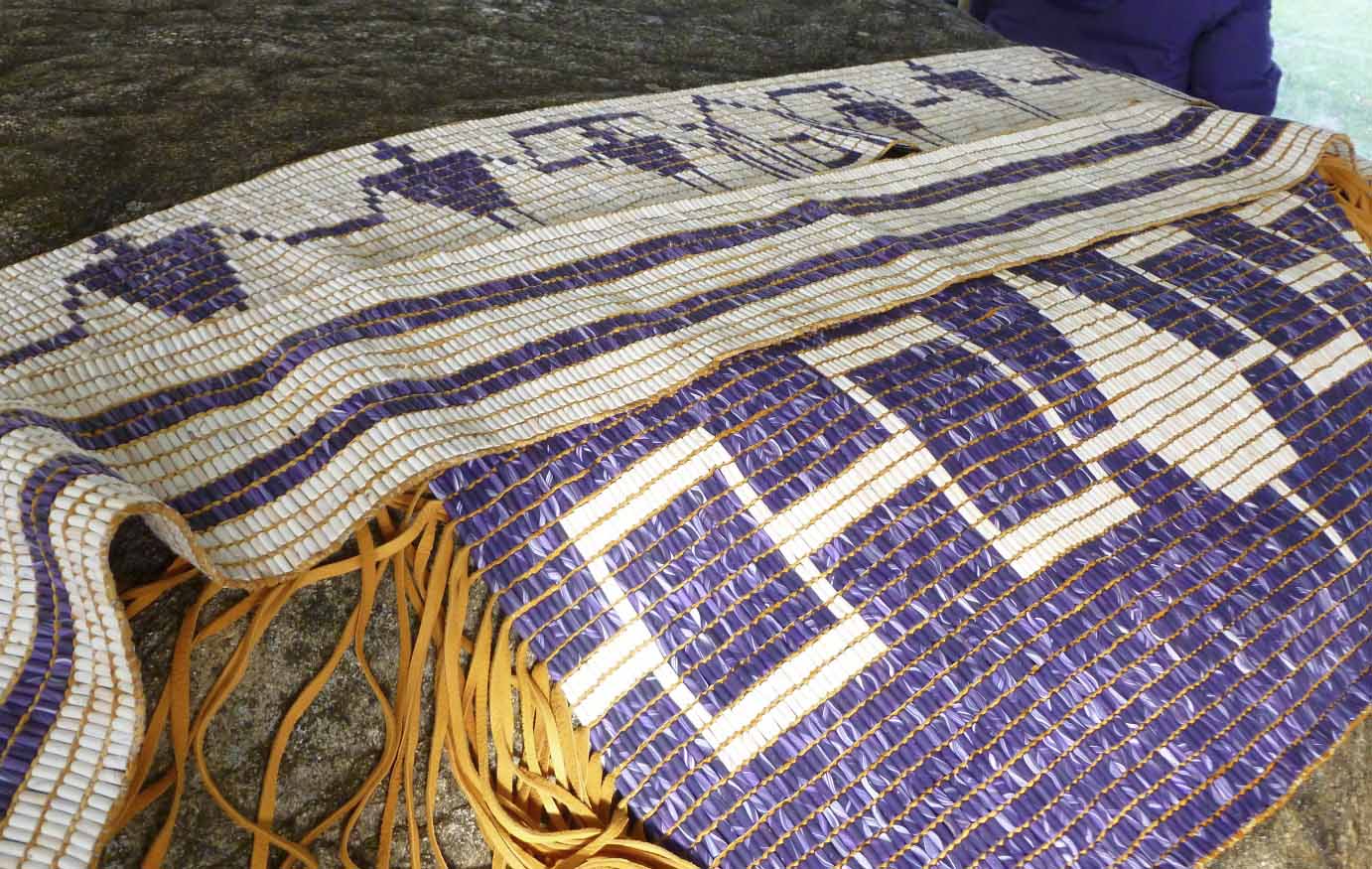City of Sherrill v. Oneida Indian Nation, 544 U.S. 197 (2005): THE DOCTRINE OF CHRISTIAN DISCOVERY AND DOMINATION AND THE DENIAL OF TREATY RIGHTS
This shameful, land mark decision by the Supreme Court was issued just three weeks after the filing of the Onondaga Nation’s Land Rights Action. It was a remarkable decision in several ways and although it was not a land claim or a land rights action, it resulted in negative impacts on the Haudenosaunee land cases, as it has been used as the excuse to dismiss the then pending Oneida, Onondaga and Cayuga land rights cases.
Less than three months Sherrill, the 2nd Circuit used that decision as the basis to dismiss the pending Cayuga land claim and in so doing, declared that Sherrill “has dramatically altered the legal landscape”1 for Indigenous nations’ land right cases. The Circuit used this new “equitable” rationale to also dismiss the Oneida Nation land claim in 2010 and the Onondaga Nation land rights action in 2012.
FACTUAL AND LEGAL BACKGROUND:
After earlier District Court rulings that illegally taken homelands could not be reclaimed in the US court system, the Oneida Nation, purchased properties from willing sellers, within the boundaries of its reservation recognized by the 1794 Treaty of Canandaigua. Since this land had been under the sovereign jurisdiction of the Nation before New York knowingly violated the three treaties, the Constitution and the Trade and Intercourse Act when it took the lands, the Oneidas took the position that any properties which they obtained on the open market, should be sovereign and under their jurisdiction once again.
Therefore, the Oneida refused to pay the local property taxes, and the City brought the dispute into state court to collected the unpaid taxes. There was no dispute that the properties were within the Canandaigua recognized Oneida reservation, which has not been terminated or diminished.
Despite this historical and factual background, the Supreme Court ruled that the City was authorized to tax the property, and in the process of reaching this incorrect conclusion, the Court concocted a new “equitable” defense, which it improperly labeled as “laches.”
In creating this new defense, the Court ignored many of the fundamental principles of equity–such as that a party invoking equity must have “clean hands” and not have been the original wrong doer, as New York state had been. Also, courts are required to balance the equities, by examining the harm to each party from different ruling. Clearly the harm to the Nations from the loss of millions of acres of ancestral homelands was far greater than any other party’s harm and yet, this was not even acknowledged. Additionally, equitable principles mandate that when there has been an injury or harm, there must be a legal remedy from the courts.
Much has been written by legal scholars in sharp criticisms of this unprecedented, rogue decision, which has been called the Plessey v. Ferguson of Indian law–because rather than correcting the history of white supremacy and colonial onslaught against Indigenous peoples, it re-affirmed the colonial rule inherent in the doctrine of Christian discovery and domination.
Consistent with two centuries of blatantly unfair rulings for Indigenous peoples, when the Court was faced with balancing the rights of Indigenous peoples against those of the settlers, it reverted to its colonial pattern of always elevating the “rights” of settlers, at the expense of the Indigenous peoples. This is essentially an unbroken pattern over the past 200 years, as the US legal system has consistently fabricated rulings to justify the illegal takings of Indigenous lands.
The United States could not have been created and then expanded across Turtle Island without the colonial seizure of Indigenous lands, the genocide of Indigenous peoples and the concentrated efforts to “kill the Indian and save the man”, via never- ending programs of forced assimilation.
SHERRILL’S RELIANCE ON THE DOCTRINE OF DISCOVERY:
The first footnote in Sherrill removes all doubt about the illegitimacy of its holding, and the clear re-affirmation of the doctrine of Christian discovery and domination, as it states that:
Under the “doctrine of discovery,” fee title to the lands occupied by Indians when the colonists arrived became vested in the sovereign–first the discovering European nation and later the original States and the United States. Both before and after the adoption of the Constitution, New York acquired vast tracts of land from Indian tribes through treaties it independently negotiated, without National Government participation. (Emphasis added.)2
There is so much cleverly hidden messaging in this footnote that it bears closer review and discussion. Initially, it quietly embraces the doctrine of Christian discovery and domination as a central theme in U$ Indian law. This should help us understand that one of our primary focuses of work going forward is to have this racist, colonial doctrine removed and denounced.
The second sentence in the footnote, is just as remarkable, to the extent that it acknowledges and then glosses over the completely illegal ways that NY took the ancestral homelands. Under what theory of international law are individual states within the United States authorized to enter into treaties?
Further, she recognizes that many of the illegal takings occurred AFTER the Constitution was effective in March of 1789, and AFTER the 1790 Trade and Intercourse Act, which clearly made such takings illegal and void. The facts acknowledged in this sentence document that New York repeatedly violated federal laws when it illegally took millions of acres of Onondaga homelands.
None of these historic realities seem to matter to the court, as she rushed to concoct this new “equitable” defense, which only applies to Indigenous nations land rights actions. This attempt to bury inconvenient historic facts in the process of creating such an inequitable result, fails all tests of intellectual integrity and must be addressed and corrected.
DIRECT CONNECTION: DOCTRINE OF DISCOVERY RESULTS IN DISMISSALS OF HAUDENOSAUNEE LAND RIGHTS ACTIONS:
The Sherrill decision came down on March 29, 2005 and less than three months later, on June 28, 2005, the 2nd Circuit used that deeply flawed decision as the basis to dismiss the Cayuga Nation land claim. There is a direct progression from the invocation of the doctrine of Christian discovery and domination 200 years ago and the dismissals of the Haudenosaunee land rights cases.
Relying exclusively on Sherrill, the 2nd Circuit dismissed the Cayuga Nation land claim, despite the earlier, clear ruling in the District Court that NY had knowingly taken the Cayuga ancestral homeland illegally and despite the fact that the only remedy awarded to the Cayugas by the District Court was a $247 million monetary judgement. No land would have been transferred and no settlers would have been inconvenienced. These details made no difference to the Circuit:
The Supreme Court’s recent decision in Sherrill has drastically altered the legal landscape against which we consider plaintiffs’ [Indian nations’ land] claims.
We understand Sherrill to hold that equitable doctrines, such as laches, acquiescence, and impossibility, can, in appropriate circumstances, be applied to Indian land claims, even when such a claim is legally viable and within the statute of limitations.
One of the few incontestable propositions about this unusually complex and confusing area of law is that doctrines and categorizations applicable in other areas do not translate neatly into those claims. (Emphasis added.)3:
Five years later the Circuit also dismissed the Oneida Nation land claim, which has been in litigation for over 40 years:
We have used the term “laches” here . . . as a convenient shorthand for the equitable principles at stake in this case, but the term is somewhat imprecise for the purpose of deciding these principles.
The Oneidas assert that the invocation of a purported laches defense is improper here because the defendants have not established the necessary element of such a defense. This omission, however, is not ultimately important, as the equitable defense recognized in Sherrill and applied in Cayuga does not focuson the elements of traditional laches. (Emphasis Added.)4
As the Circuit proceeded to dismiss all the Haudenosaunee land rights cases, it simply made up new rules, which only apply to Indigenous land rights cases and which they admitted were different. There is a double standard, and Indian treaties no long matter in US law.
The final shoe to drop was the 2012 dismissal of the Onondaga land rights action by the Circuit:
This appeal is decided on the basis of the equitable bar on recovery of ancestral land in Sherrill, and this court’s cases of Cayuga and Oneida.
[Three specific factors determine when Indigenous land rights cases are foreclosed under these inequitable rules]:
- The length of time at issue between an historic injustice and the present day;
- The disruptive nature of claims long delayed; and
- The degree to which these claims upset the justifiable expectations of individuals [i.e.: settlers] far removed from the events giving rise to the plaintiff’s.5
Therefore, because all of NY’s illegal takings of Haudenosaunee lands are more than 200 year old, US courts provide no remedy for admittedly illegal land grabs and treaty and federal law violations. There clearly is no justice or equity for Indigenous peoples in US courts.
For this reason, the Onondaga Nation filed a Petition in the Organization of American States Inter-American Commission on Human Rights which charges the US with human rights violations for the illegal takings of the ancestral lands, for the environmental destruction of the sacred Onondaga Lake and other massive damages to the homeland; and because the US court provide no remedy for treaty violations.
It’s time for justice, time for peace.
Joe Heath Onondaga Nation General Counsel
Resources
- City of Sherrill v. Oneida Indian Nation of New York 544 U.S. 197 (⤓ PDF Download)
- City of Sherrill v. Oneida Indian Nation of New York 544 U.S. 197 via Cornell Legal Information Institute
- Heath, Joseph J. The Doctrine of Christian Discovery: Its Fundamental Importance in United States Indian Law and the Need for its Repudiation and Removal. 10 Alb. Govt. L. Rev. 112 (2017) (⤓ PDF for Download).
- _____. A Brief History of Haudenosaunee Treaty Making and The Obligations of the United States to Protect Haudenosaunee Lands and to Not Disturb the Free Use and Enjoyment Thereof. (⤓ PDF for Download).
- _____. The Citizenship Act of 1924 was an Integral Pillar of The Colonization and Forced Assimilation Policies of the United States in Violation of Treaties. (⤓ PDF for Download).
- _____. Nations Are Sovereign; They Are Not “Tribes.” (⤓ PDF for download).
- _____. Statement on the Historical Use of the Doctrine of Christian Discovery by the United States Supreme Court Since 1823. (⤓ PDF for Download).
Footnotes
-
Cayuga Indian Nation v. Pataki, 413 F. 3d 266, 273 (2nd Cir, 2005). ↩
-
617 F. 3e 114, 127 (2nd Cir. 2010), Cert. denied, 565 US 970 (2011). ↩
-
Onondaga Nation v. New York, 500 F. App’x 87, 90 (2nd Cir. 2012). ↩
SUGGESTED CITATION
Joseph J. Heath, "City of _Sherrill v. Oneida Indian Nation_, 544 U.S. 197 (2005): THE DOCTRINE OF CHRISTIAN DISCOVERY AND DOMINATION AND THE DENIAL OF TREATY RIGHTS," Doctrine of Discovery Project (6 February 2023), https://doctrineofdiscovery.org/blog/sherrill-v-oneida-doctrine-christian-discovery-denial-treaty-rights/.
Donate today!
Open Access educational resources cost money to produce. Please join the growing number of people supporting The Doctrine of Discovery so we can sustain this work. Please give today.


